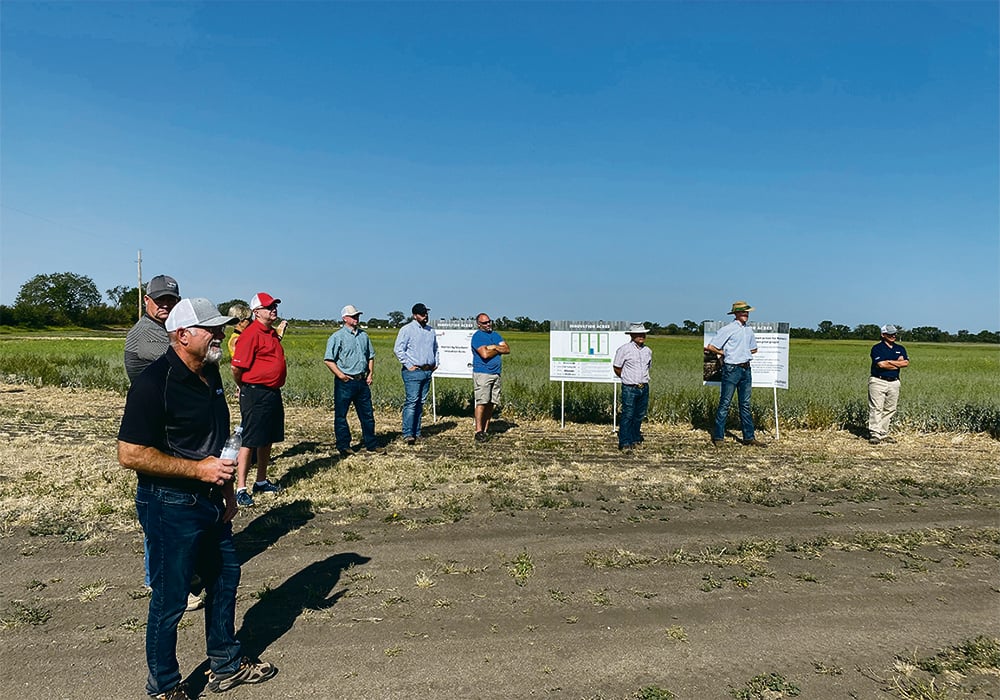There’s nothing like drought to hammer home a point.
Quit wasting money growing annual crops in marginal areas, advises Lyle Cowell, Nutrien’s manager of agronomy services. Instead, farmers should focus resources on the best acres and use marginal land to grow forages.
“It’s a simple concept, but I don’t hear too many people talking about the redistribution of resources on farms,” he said.
Cowell spoke during a morning of plot tours at the Glacier FarmMedia Discovery Farm near Langham, Sask., before a general meeting of the Saskatchewan Forage Council last month.
Read Also

Canadian Food Inspection Agency extends chronic wasting disease control program consultation deadline
Date extended for consultation period of changes to CWD program
“One thing that every farmer has in common is that they’re trying to make a living. Whether you are a farmer who is very concerned about marginal lands in terms of the environment, or you just want to make a maximum amount of money, the end objective is exactly the same,” he said.
“If you have land that is consistently losing money every single year, it really doesn’t matter if you even harvest the hay. It comes down to you have to stop losing money.”
Cowell said the best profit from marginal lands comes from reduced spending, not hay sales.
“You might make $100 or $200 an acre of hay, but you might save $200 or $300 an acre. Then you can actually multiply that money by spending that money that’s no longer being wasted on your best 20 percent of land,” he said.
Jeremy Brown, agrologist with Ducks Unlimited, emphasized the point.
“If you take the inputs that you were putting in those areas and spread those over the best acres in the field, your total yield will actually go up. So you’ll have fuller bins farming a few less acres.”
Even during a drought, Cowell said there’s no excuse for a lack of livestock feed.
“Saskatchewan has no shortage of land that is well suited to growing forages. We have a shortage of forage, but that’s our own doing. We’re trying to grow annual crops that are poorly suited to forage that are actually well suited to forage acres,” he said.
“We call them marginal lands, but they’re not marginal for forage acres generally. They’re just marginal for growing annual crops.”
“In the end the answer is always the same thing. Forages are often the right thing to grow there,” Cowell said.
Redistribution of money doesn’t mean farming fewer acres.
“You can balance that, ironically, by producing more crop on your best acres and actually filling your bins as good as you ever did with less effort,” he said.
“It doesn’t just affect your retail type costs, your annualized costs. It affects your fixed costs, like what you need for equipment and how well it’s maintained.
“It takes very little time to farm your best acres. It takes a lot of time to farm your worst acres.”
Producers should also think beyond growing and selling forages and expand to other plants, such as trees.
“You see that in other areas like southern Ontario or a lot of Europe. Their marginal lands are reforested. Other areas of the world do it in more productive farmland than in Saskatchewan. Our answer tends to be forages because most of our land is on the Prairies,” said Cowell.
Tamara Carter, like many farmers, gambled that short-term profits ($10.80 canola last year, $20 this year) would yield a healthy margin this year.
However, she now recognizes it’s time to take action on her family’s 6,000-acre mixed farm.
“It has just been driven home for me again that this is important. We’ve talked about it in our family and it just hasn’t happened yet for one reason or another. It has to be an area that gets prioritized,” said the president of the Saskatchewan Forage Council.
Added Cowell: “Sadly, I saw a lot of forage acres, a lot of pastureland on very poor soil types removed this year with the expectation that people were going to remove hay land and seed it to canola and have a great crop of canola on very poor soil and hoping for a lot of income.
“Most of those acres are going to produce close to nothing this year. At the same time, we could have had a very profitable crop of forages. So it should be a wake-up call, but it seems to take a while to resonate with farmers.”
















